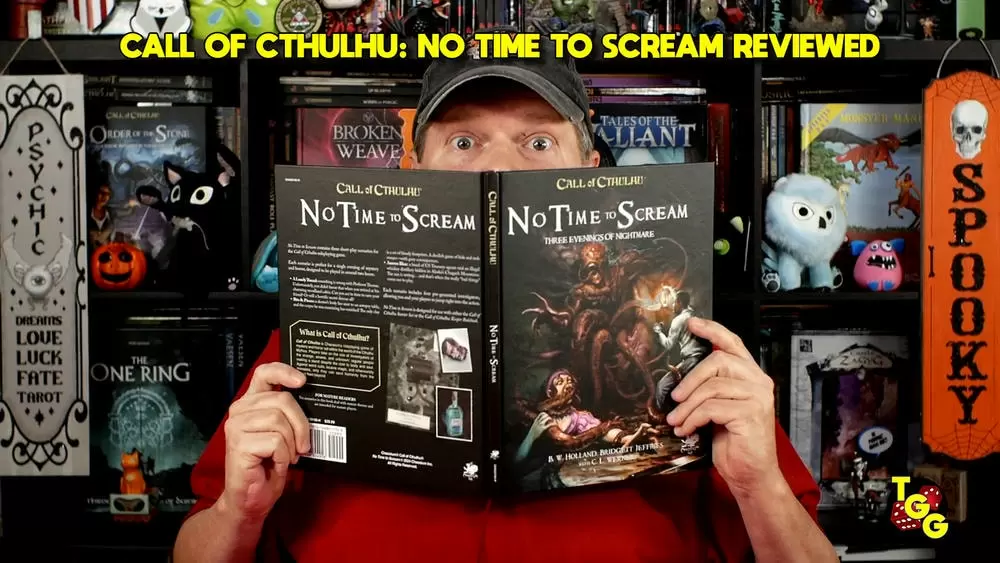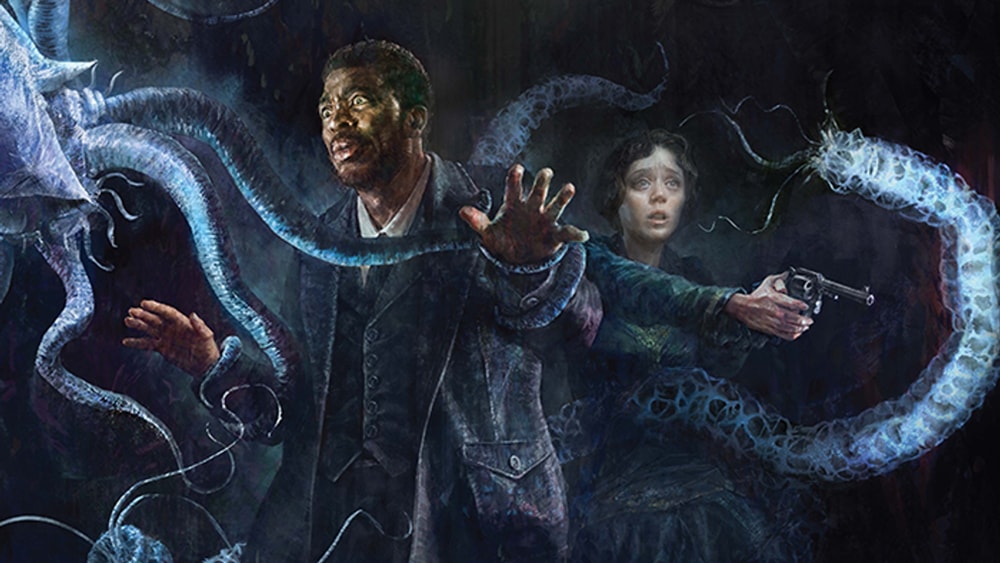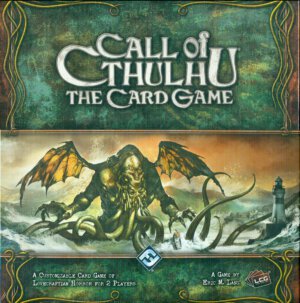
Publisher: Fantasy Flight Games
Designers: Eric M Lang and Nate French
Year: 2004
Players: Two players (Multiplayer rules available)
Ages: 13+
Playing Time: 30 to 60 minutes
Category: Card/Strategy Game
Retail Price: $39.95
I believe Call of Cthulhu the Card Game was Fantasy Flight Games first entry in the Living Card Game series. As such, it has had time to mature over the years. Many expansions (called Asylum Packs) have been released since its creation. The game seems to lack some of the depth and complexity of their future releases, Lord of the Rings being a prime example. However this does not deter from the game itself, and actually makes it an excellent introduction to the entire Living Card Game (LCG) series.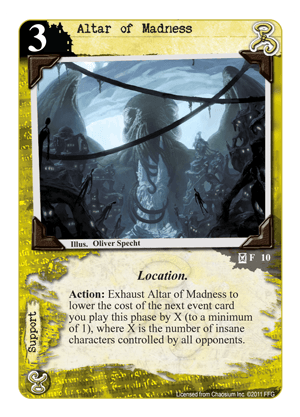
Upon opening the game and removing the rulebook, I was met with the same high quality and thick set of rules I have come to expect from all of FFG’s releases. This was deceiving however, because when I reached page 15 the rules ended and the rest of the book consisted of information/advertisements on the Asylum Packs that have been released. I realized that actually learning the game was going to be a piece of cake.
This review is concerned with the original boxed set only, as I have not had an opportunity to play with any of the expansions.
For those unfamiliar with the concept of a Living Card Game, the gist is that the initial set of an LCG contains all of the cards and components necessary to play many two players game sessions and enjoy yourself. The company then follows up with periodic expansion sets of cards that use can add to the base set to give it more depth and allow players to customize their decks that they use against other players. There is no collectability aspect, as all expansions contain the same deck of cards. If one person picks up a copy of the “At the Mountains of Madness” Asylum Pack, he will get the same cards as every other player who purchases the same pack. For the completist this will mean purchasing all of the Asylum Packs that are released of course, but you don’t need to worry about purchasing 30 boosters to try to get the cards you want.
Call of Cthulhu is a story based game system. Players are competing against each other to collect enough clue tokens, five to be exact, to complete a specific story card. The first player to collect three story cards wins the game.
The players must fight against each other for control of these story cards though, each using the characters, support cards, and events in their own decks to attempt to place clue tokens on their side of the visible story cards. The other player tries to stop them.
But first the components. The cards are excellent quality and are wonderfully illustrated. Clue tokens are well done and have wound markers on their backs making them interchangeable. So you don’t need to spend time separating out the different markers as you do in so many other games, which is nice.
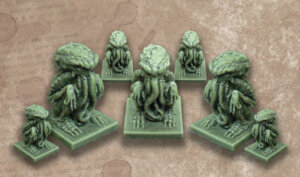
The most impressive components though are the Cthulhu domain markers. These are small (about 2”) resin figures designed to look like a squatting Cthulhu. They are nicely done. The game comes with six of these figures, and they are used to mark when you have drained a resource pool during your turn. I like these. FFG could have just added some tokens or told you to “Tap” the resource pool when it is used, but instead they included these figures.
The box is big and airy. It has plenty of room to include additional Asylum Packs. Your cards will all be loose rattling around in the box unless you come up with your own storage solution though. I wish that Fantasy Flight would take a page from AEG’s book and take the storage solution into consideration when publishing an expandable card game such as this. They could have easily included several smaller rows within the box, and divider cards so that you could separate out the different factions, story cards, and Asylum packs all within this huge box the game comes with. Even a one row inner box would be able to contain many expansion packs in a nice neat order, but I know Cthulhu means chaos so what can you do.
On to the game itself. Call of Cthulhu comes with ten story cards. A story card is really nothing more than a card with a title and a nice piece of descriptive artwork in landscape, plus an event listed at the bottom that you can trigger if you win that story card. So ther is really no story involved. These are shuffled and placed in a draw pile at one end of the board between both players. Three of these cards are flipped up initially and placed into their slots on the game board, ready for the players to start placing their clue tokens on them.
The remaining cards will make up each players deck. There are seven factions in the game, some being human and others being 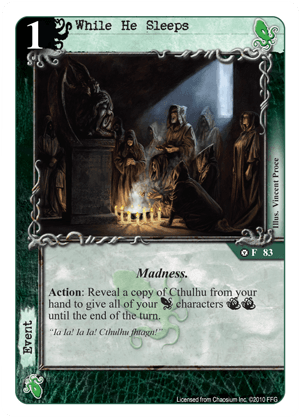
Each player takes three unused cards and placed them face down in front of them. These will be your Domain pools. Think of them as mana or energy pools where you will place resources to draw on to pay the cost of putting your other cards into play. They each draw eight cards from their decks and use three of these cards to place under their domains to form their initial resource pools.
Every card has an icon at the bottom specific to the faction the card belongs to. Rotate the card 180 degrees and slide it so that only this resource icon is visible and poof, there is your mana. You won’t be able to use that card for anything else though, once you place it into one of your domains.
The remaining five cards form your initial hand. There are several types of cards that you will be able to play during your turn. Character cards are the people or creatures that will go out and investigate the various stories in an attempt to gather the clues you need. Support cards can be attached to the character cards or stand alone, and give different bonuses. For example, a .45 automatic is a support card. Events work as you would expect, giving help to you or problems for your opponent. Finally, Conspiracy cards are additional story cards that you can play and win right from your deck. The base game only has one of these.
A turn consists of refreshing your domains to start with a fresh resource pool. Drawing two cards. Adding a new card to one of your domain resource pools if you wish. Playing cards, and committing characters to stories to try to win clue tokens on that story.
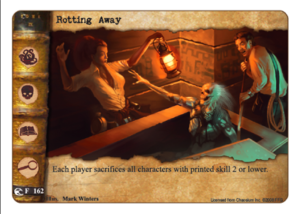
To play cards, you must drain one of your domains to pay its cost. You can only use one domain to play a card, so if something costs four resources to play, you must have four resources in one of your domains in order to play it. Additionally, one of those resources has to be of the same faction as the card you are trying to play. To drain a domain, just place a handy Cthulhu figure on it. Unused resources don’t carry a penalty, so you can pay extra if you need to.
Place the played card on the table, and carry out any actions that it dictates. In many cases these will be characters that you intend to commit to one of the stories. You may play as many cards as you can afford with your available domain resources, up to a max of three because you only have three domains to pull from.
The story phase comes last. You commit the characters you choose to the stories you wish. Your opponent does the same. You then proceed through fours phases and determines a winner for each by counting the number of icons on each committed card on each story. Whoever has more terror icons wins the terror phase, causing one of the losing players characters to go insane. Whoever has more combat icons wins the combat phase and wounds one of the losing players characters, and so on. During the final resolution, the players with more total icons wins the battle and gets to place a clue token on that story. Many times you will be able to place two or 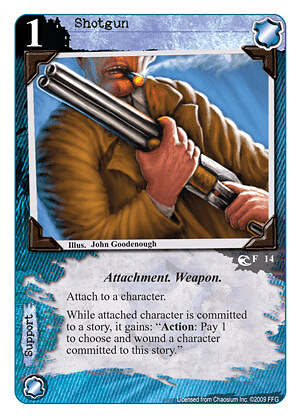
Once you have five clue tokens on a story, you win that story. Win three stories and you win the game.
There is a lot more intricacy than this. There are many traits that affect game play. Each card has some ability that they can use or occurs when they are played. You will need several plays to get the feel for all of the cards and to start developing your own strategy.
This game is well done. I enjoy it quite a bit, and am looking forward to getting some of the Asylum packs to expand my options. It is fairly easy to learn, and has never taken more than an hour to play. It is not quite as thematic as I enjoy, the story cards are not really stories, but it is enough.
One suggestion I might make. My first game I choose to play all human factions, while my opponent played all mythos factions. Well, my cards were more expansive to cast in general, and I had no terror icons on my cards (I am only human). The terror phase happens first, so I found myself at a great disadvantage. By the third turn my opponent had six creatures out, and I had two. He simply could drive these insane and collect two clue tokens on each story every turn and it was over quickly. I was able to give him a run for his money by the end, but it was too late. So make sure you mix it up a bit when choosing your factions.
[rwp-review id=”0″]
- A Dungeon Delve for Kids?: A Review of Dungeon! - Oct 24, 2022
- Better, Stronger, Faster | Descent: Journeys in the Dark Second Edition Reviewed - Oct 23, 2022
- Your Planet is Doomed!: Invasion from Outer Space Reviewed - Oct 22, 2022



